
|
bridle head measuring.pdf Size : 7192.153 Kb Type : pdf |
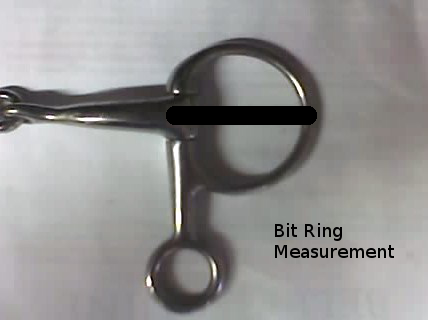

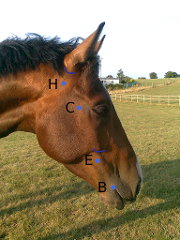
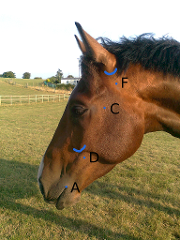
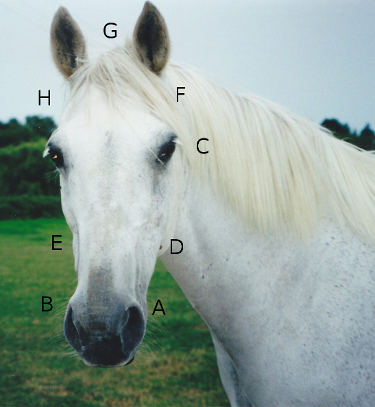
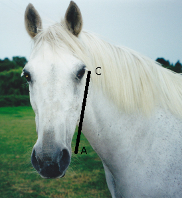

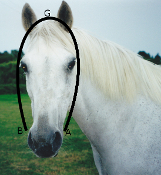
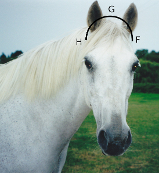
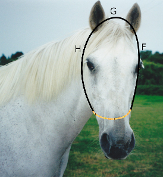
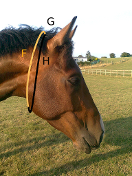
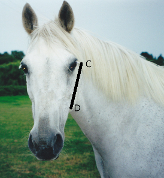

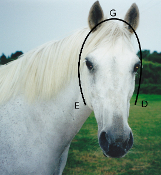
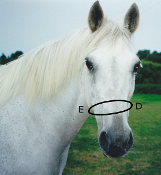
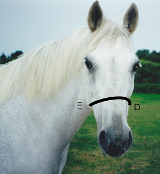
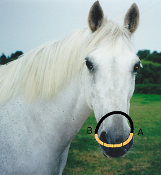
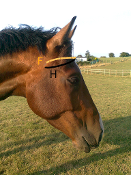
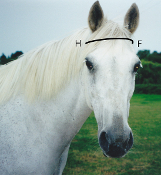

|
Bridle Measurements Form.pdf Size : 152.999 Kb Type : pdf |

|
Existing Bridle Measurements.pdf Size : 157.101 Kb Type : pdf |
To achieve a good fit for your handmade bridle you need to either measure your horse's head or take some measurements from a bridle that fits the horse. This bridle doesn't have to be a made-to-measure one, just one that fits.
Measuring your Horse for a made-to-measure bridle.
If you don't have a bridle to fit to your horse that you can measure, you can always take the measurements directly from your horse's head.
To start you will need a fabric tape measure, pen and paper, and some chalk or stickers. And if possible someone to help you!

|
bridle head measuring.pdf Size : 7192.153 Kb Type : pdf |
Bit Rings
The first measurement you need are not actually on the horse but the bit you will be using. Measure from the outside edge of the ring to the end of the mouthpiece.


Now for the horse!
The points used to measure for a bridle are:
A – the corner of the mouth.
B – the corner of the mouth on the other-side.
C – a point level with the horse's eye.
D – a point two fingers (about an inch) below and behind the horse's cheek bone.
E – the same point on the other side of your horse's head.
F – a point two fingers below and behind the base of the horse's ear.
G – the top of the horse's head (poll).
H - a point two fingers below and behind the base of the horse's other ear.
To make it easier, and to ensure that you always measure from the same points each time, mark points; C, D, E, F, and H on your horse's head with the chalk or stickers.



Headpiece and cheeks
AC – measure from the corner of the horse's mouth to the point level with the eye.


AGB – measure from the corner of the horse's mouth, over the poll, and down to the corner of the mouth on the other side.

FGH – measure from behind and below one ear, over the poll, and down to below the other ear.

FHF – measure from the same point under the ear, under the horse's throat and back up to under the other ear, over the poll and back to the 1st ear again. Allow enough slack to get four fingers under the tape. Alternatively you can measure FH under the throat and add it to FGH above.


Noseband
CD – measure from the point level with the horse's eye down to two fingers below the cheek bone.


DGE – measure from the point below the cheekbone, over the poll, and down to the point below the other cheek bone.

DED – measure around the circumference of the horse's nose two fingers below the cheek bones. You should leave enough slack to get two fingers under the tape.

DE – measure from the point behind the cheek bone, around the front of the horse's nose, to the point behind the other cheek bone.

ABA – Measure from A at the corner of your horse's mouth to a point approximately 1-inch below where the bottom of the noseband will be at the centre of your horse's nose, around the circumference to B and under the jaw back to A.

Browband
FH – measure from behind one ear, around the horse's forehead, to behind the other ear. Leave enough slack to get two fingers under the tape.


These measurements will give me the following information to enable me to make a made-to-measure bridle. Ideally all buckles will be buckled up on the middle hole and level with the eyes where appropriate.
Headpiece
AC – the length of the cheek pieces. The size of the bit ring will be subtracted from the measurement. Make sure you let me know if you have measured from the corner of the mouth or from a bit that the horse was wearing.
AGB – the length of the cheek pieces and headpiece when the bridle is buckled up on the middle hole. Again if this was measured from the corner of the mouth then the bit ring measurement times two, will need to be subtracted from the overall dimension.
FGH – the distance between the splits on either side of the headpiece.
FHF – The length of the throatlatch from the buckle to the middle hole.
CD – the length of the noseband cheek piece.
DGE – the total length of the noseband headpiece when buckled on the middle hole.
DED – the length of the noseband when buckled up on the middle hole.
DE – the distance between the noseband headpiece and the noseband cheek piece.
ABA – the length of the flash strap from the buckle to the middle hole.
FH – the measurement of the browband not including the loops on either end that fit around the headpiece.
Other information
I will also need some other information that provide for that truly made-to-measure experience. These include;
Width and style of the cheeks.
Width and style of the throatlatch.
Width and style of the noseband.
Width and style of the browband.
Double bridle.
Padding.
Any other specific design ideas.
Ordering
Use the form below to complete your order. The file is a pdf form that can be completed and emailed to me, or alternatively, print the pdf and post the completed form to me.

|
Bridle Measurements Form.pdf Size : 152.999 Kb Type : pdf |
Measuring from a Horse bridle
Tips when measuring from an existing bridle
Firstly you need a bridle that fits the horse. With the bridle fitted to the horse get some ideas if anything needs changing. In particular look at where the cheek piece buckles are in relation to the horses eyes. If they are level with the eyes then when it comes to measuring the bridle you can simply measure the cheek piece. If the buckles are too high then reduce the dimension by an appropriate amount, if they are too low then add to the dimension.
To measure the bridle you will need to remove the browband and the noseband, but reassemble the cheeks into the holes that you use.
Lay the bridle out flat to measure it.
Measure the entire headpiece with the cheeks attached from the loop made where the bit goes to the other bit loop at the opposite end.
Measure the cheek piece from the bit loop to the buckle. This is the measurement that may need to be altered if the buckles are not level with the horses eyes.
Measure the length of the throatlatch from the buckle to the hole that it is usually buckled through.
Now take the browband and measure its length from where the loops are stitched at each end. I don’t need the loops as this will change depending on the bridles width.
Put aside the browband and take up the noseband. Firstly measure the length of the noseband from the buckle to the hole that it buckles to.
Finally take the measurement of the noseband headpiece. With the head buckled up measure from the top of the noseband back to the top of the noseband on the opposite side. Also make a note of the short length to the buckle. Again this buckle should also be level with the horse's eye.
Notes
If you are taking these measurements from an existing bridle remember to measure from the buckle to the hole that you are using on your Horse. This will ensure that when your new made to measure handmade bridle arrives it should buckle up on the middle hole of each strap.

Ordering
Use the form below when you are measuring from an exsisting Horse bridle. It is a pdf that can be completed electronically and emailed to me. Alternatively you can print the form, complete it and post to me.

|
Existing Bridle Measurements.pdf Size : 157.101 Kb Type : pdf |
The way I like to measure for a Horse bridle consists of a mixture of the two options above.
The headpiece and cheek pieces.
To start you will need; a flexible measuring tape, bridle measuring forms from my website or paper and a pen, and an old bridle to put on your horse.
Fit the bridle to your horse, it doesn't have to fit perfectly, but just needs to hold the bit in the correct place.
Take the measuring tape and measure from the turn on the cheek piece where it holds the bit ring, over the horse's head, and down to the cheek piece turn on the other bit ring. Note that measurement, or better still have someone else note it down for you! While you have the tape there also note down the distance between the bit ring and a point level with the horse's eye. This will be the length of your cheek pieces.
The next measurement that you need is from a point about 1 inch below the base of your horse's ear over the poll to 1 inch below the base of the other ear.
Lastly with the tape still in place measure the throat latch all of the way under the horse's throat, up and over the poll, and back to the start of the tape under the horse's ear. This will make up the length of the headpiece, remember to allow 4 fingers slack for the throat latch.
The noseband.
The first measurement you will need is a distance two fingers below the horse's cheekbone, over the horse's head and down the other-side to the same point below the other cheek bone. Whilst the tape is there also note down the distance from two fingers below the cheek bone to a point level with the horse's eye.
The next measurement you will need is the circumference around the horse's nose where the noseband will sit. Again this will be two fingers under the cheek bone. You should allow two fingers slack in the measurement. Whilst this tape is there also consider measuring from just behind the cheek bone around the front of the horse's nose to just behind the other cheek bone.
The browband.
This one is quite simple – measure from the front of the headpiece, it should be about 1-inch behind the back of the horse's ear, around the horse's forehead, to an equivalent point on the other side of the horse's head, again about 1-inch behind the ear. You should allow a slack of two fingers in this measurement.
I will also need the width of the headpiece.
These measurements will give me the length between the loops and the overall length of the browband. Don't get confused when you buy a browband from your local shop as the size they give will be the entire length of the browband, including the loops at each end. The problem with this is that different sized headpieces require different sized loops.
Flash strap.
A flash noseband is very common but the flash strap is often overlooked when a bridle is fitted. Usually far too long with the point flapping about in the wind, or held up with a plaiting band!
Simple to measure for. Take a measurement around the Horse's nose. Start on the centre front about 1-inch below where the bottom of the noseband will be. You measure form just below because when the flash is tightened it tends to pull the front of the noseband down a bit. Now take the tape around the nose/mouth, under the bit and back to the start. This measurement will be from the buckle point to the centre hole.
The flash strap will have a running loop to keep the point under control and can be fitted with the point facing up or down.
If you want just a standard size bridle then check my standard sizes for a bridle that may suit your needs. Available in Pony, Cob, Full, and Extra full/Oversize

|
Bridle Measurements Form.pdf Size : 152.999 Kb Type : pdf |

|
Existing Bridle Measurements.pdf Size : 157.101 Kb Type : pdf |